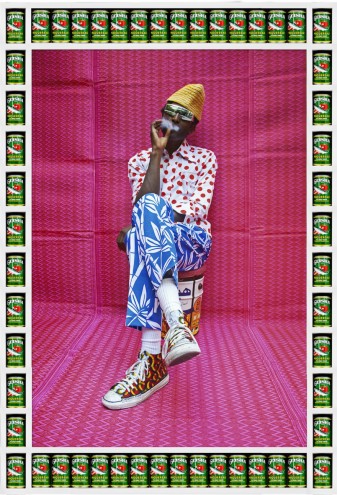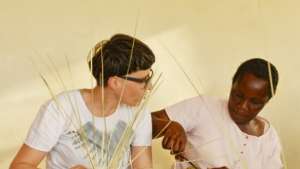From the Series
Born in 1961 in Larache, a small Moroccan fishing port, photographer Hassan Hajjaj moved to the UK at age 13. As a schoolboy in London, he was thrown into what was for him a new urban culture, where his lack of English or metropolitan know-how initially made it hard for him to fit in with his peers.
A year-long “crossroads” ensued, during which he had to learn a new language and navigate British culture. His London home became a sanctuary where his parents and four siblings “ate Moroccan food and nothing else”, and where smells “from mint tea to sardines and tagines” could often be picked up even before you reached the front door.
It’s this teenage experience in 1970s London that may have set in motion an artistic sensibility that has since placed Hajjaj on a creative path of playful but heartfelt expression. The clash of cultures from two continents ultimately comes through in his images and by turns speaks volumes about his North African roots.
Self-taught, he turned to photography in the late 1980s and immersed himself in London’s hip-hop and reggae culture, forging many friendships that still play a role in his work today. His ongoing signature series “My Rockstars” features these friends, many of whom are now celebrated designers, musicians, artists and writers.
His first book, By Hassan Hajjaj, includes this series alongside other equally vibrant and unconventional portraits such as the “’Kesh Angels”, a tribute to Marrakesh’s female bikers.
For both projects Hajjaj depicts his subjects in bold, almost cheeky, poses and styles them in highly patterned, brightly coloured clothing and settings. The photos are frequently finished off in frames made of recycled materials such as painted tyre rubber or Arabic-script drinks cans.
Both series have been showcased internationally – “’Kesh Angels” at New Yorks’ Taymour Grahne Gallery at the beginning of this year and “My Rockstars, Volume 1” at the Third Line Gallery in Dubai in 2012.
The acknowledgement from the Middle East is significant, not least because the series has been a long time in the making – Hajjaj started it back in 1999. The fact that his work was picked up by a gallery in the United Arab Emirates shows that Moroccan art and artists – both entities having been sidelined within the art world – are becoming part of the creative conversation as the Western world's interest in Arab art and the Middle East has grown within the last decade.
That’s not to say that Hajjaj is being held aloft as a representative of North African photography, but over the years he’s proven to be no slouch (with the help of his agent, Rose Issa) when it comes to getting his images out to a wide audience. A respectable cluster of prizes includes a 2003 French award for the interior design of the Andy Wahloo Bar in Paris, a 2009 nomination for the Victoria and Albert Museum’s international Jameel Prize for Islamic-inspired contemporary art and design and the 2011 Sovereign African Art Prize
Despite his UK base (he owns a boutique store called Larache in East London), his technique of weaving performance and fashion into his photography is as much informed by his initial Moroccan upbringing as it is by London’s world of catwalks, club nights and parties that he was embedded in during the 1980s and 90s. He tells a story of his North African childhood, when his mother would dress him up in clothes sent from his father in England, before spraying him in perfume and taking him along to the local photo studio for a family portrait. “I think there’s a picture of me somewhere, dressed up as a cowboy,” he says.
It’s likely that this early studio experience may have found its way into his work, particularly the “Rockstars” series where sitters are dressed in a combination of their own and Hassan’s creations, with materials that he sources from Morocco.
I try to get all the stuff that I use from the medina, he explains. They may be things that have been bought cheaply, but I make them look grand.
He’s also keen to point out that his work does, in fact, go beyond being a studio shoot. Comparisons have been made with the palette of 1960s psychedelic art and also the sitting styles of Malian photographers Seydou Keita and Malick Sidibé – “the masters” according to Hajjaj – although he still cites his Moroccan childhood as his biggest influence.
The fact that Hajjaj designs most of the clothes in his shoots is also a way of imprinting his culture within what he sees as visual documentation. The global backgrounds of his sitters are also key to his work. There will often be a nod to the early immigrant experience that he shared with many of his teenage peers, who would have had similar trans-cultural journeys. He literally constructs this narrative in shots such as one featuring fashion designer Joe Casely-Hayford, dressed from head to toe in Hajjaj’s designs, apart from the designer’s own shoes.
“I like having a Moroccan photographer shoot a Ghanaian in London using mats from Senegal,” Hajjaj says of the photo. “The tailor chose a fabric that’s used for making parasols. The pattern looks like 60s wallpaper. The hat and socks are Moroccan, and the seat is made from African fabrics from a London market.”
With almost three decades of photography behind him, Hajjaj says he is still growing and experimenting. He’s busy working on a documentary film, Karima: A Day in the Life of a Henna Girl, as well as another personal project on Gnawa musicians of North and West Africa that has been in progress for the past 15 years but hasn’t shown yet.
Lately, there’s been a perfect alignment of opportunity, interest and considered appreciation of his work, which has meant a year of pretty intense travel for solo or collaborative exhibitions in New York, Los Angeles, Morocco, Tunisia and, most recently, the 1:54 African Art Fair in London. However, despite lengthy periods away from his family and the fact that “it can get tiring”, there’s no indication Hajjaj will be stopping soon.
"By Hassan Hajjaj" is available from the Rose Issa Gallery in London or online for £30 (plus postage abd packaging) at www.roseissa.com
Nana Ocran writes about contemporary African popular culture for international publications including Virgin Atlantic, Wings Magazine, Selamta Magazine and S14. She is also a Pan African trends watcher for Paris-based think tank Breakthrough Innovation Group (B.I.G.).















